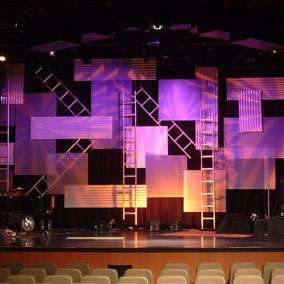
Kitty_K
5 Years Experience
Los Angeles, CA
Female, 30
I am a Los Angeles based decorator and have worked on a range of projects from an Academy Award winning feature to commercials for brands like Bank of America and Kay's Jewellers. An average day on the job involves me visiting high-end stores and prop houses in Los Angeles to photograph and price furniture, lighting fixtures, drapery, and art. I am responsible for running a crew and collaborating creatively with the director, production designer and cinematographer. Ask me anything!
There are a few ways that budgets for art department are kept down. One: You borrow from your own "kit". Over time, people who have worked for a while in art department accumulate items - props, art, set dressing - from sets that they've either put their own money into or was acquired by them after wrap. If you borrow from your own kit, it's free. Two: It's not something that we enjoy doing but if an item is needed and we don't have the money for it, it will be bought from a department store and then returned at the end of shoot. Three: Asking for discounts or deals from prop houses or stores. If you're a frequent customer at a particular showroom, they may be willing to cut you a deal depending on your customer status.
The amount of creative control you are given on a project depends on the director. Some directors are extremely particular about what they want and others give you free reign. When a company selling a product is involved, the director/producers are often much more picky about what they want because they want to project a certain image to sell that product.
Sometimes I wish this field was slightly more stable financially. It's not fun not knowing where your next paycheck is coming from- although I guess that uncertainty and risk is the trade off of having a job where you get to play grown up make believe all day.
To a degree, CGI and the new advances in green screen have taken away jobs from art dept, mostly on big budget science fiction films (Star Wars, Avatar, etc) However, at the end of the day most actors rely on set decoration, set dressing and props to help immerse themselves into the character and setting. That is not something that will change, even as film making becomes more technologically advanced. Also, super low budget films have become sort of a trend of late and good CGI is not cheap. I don't see a future where all film sets will be green screen and motion capture. I think some of the lazy story telling we've been seeing lately in Hollywood is really the enemy of traditional set design, not CGI. It is possible to utilize digital effects tastefully to tell a story and still let the art direction shine (Terminator 2, Jurassic Park, The Matrix, Fight Club, etc) Hollywood has gotten so used to making movies that make money as opposed to making movies that tell stories, that the artistic quality of our films has suffered overall.
Call Center Representative
 What is the meanest thing a caller has ever said to you?
What is the meanest thing a caller has ever said to you?
Videogame Reviewer
 Pick one: Nintendo Ice Hockey, NHL ‘94, or Blades of Steel?
Pick one: Nintendo Ice Hockey, NHL ‘94, or Blades of Steel?
Dry Cleaner
 Why don't more dry cleaners stay open late?
Why don't more dry cleaners stay open late?
...Me personally? I am a collector of antiques and vintage knick knacks- and if I can, I try to dress one or two items from my collection into the set of each project. For example, a vintage Pac Bell radio got dressed into the set of an Estelle music video I did. Also, my first feature film years ago called for a youthful pop-y look so I brought in a bunch of classic vinyl records I own, my bright yellow 70s rotary phone and some stencil art paintings I hand made. Cleared art is a big dilemma in set decoration - many pieces of art are copyrighted to the artist or company that manufactures copies of the art. You can't buy a piece of wall art from Z Gallerie, hang it up on a set and expect to not get sued. You must go through a legal process to obtain permission from the artist or company beforehand. Renting copyright cleared art can be pricey - a single piece can start at as much as $150 per wk. So for this reason if it's called for- such as on a Special K commercial I did recently- I do bring some of my own black and white 35mm prints to set. It saves money and allows me to incorporate a personal touch to my work.
During a job, the standard is either 10 or 12 hour days. Depending on the project it can last for a few days or maybe months with some days off in between. The timing is often sporadic, there is no 5 day work week, sometimes work can cross over into the weekend but end on a weekday. Sometimes the work day can be unbearably long - like a 16 hour day or even longer. This is completely unethical and wrong but it happens because productions can be greedy and they want to get the biggest bang for their buck out of the crew. Famed cinematographer Haskell Wexler directed a documentary called "Who Needs Sleep?" about the problem of overworking film crews to the point of harming their health and in extreme cases, ending their lives. It is a serious issue that people working in the film industry still deal with today.
Signing up for the SDSA is a great idea - attend as many GMM meetings as possible and make your face familiar. Start working on low budget or non union projects, offer to Art PA on commercials or TV shows and familiarize yourself with the prop houses. The shortest path to becoming a decorator is acting as a shopper. Decorators want shoppers who have a good eye and know where to find what they want. Shoppers are asked to source all kind of things - everything from vintage mason jars to cryogenic tanks. If you can prove yourself knowledgable in where to locate things like this - you are on the right path.
-OR-
 Login with Facebook
Login with Facebook (max 20 characters - letters, numbers, and underscores only. Note that your username is private, and you have the option to choose an alias when asking questions or hosting a Q&A.)
(A valid e-mail address is required. Your e-mail will not be shared with anyone.)
(min 5 characters)
By checking this box, you acknowledge that you have read and agree to Jobstr.com’s Terms and Privacy Policy.
-OR-
 Register with Facebook
Register with Facebook(Don't worry: you'll be able to choose an alias when asking questions or hosting a Q&A.)